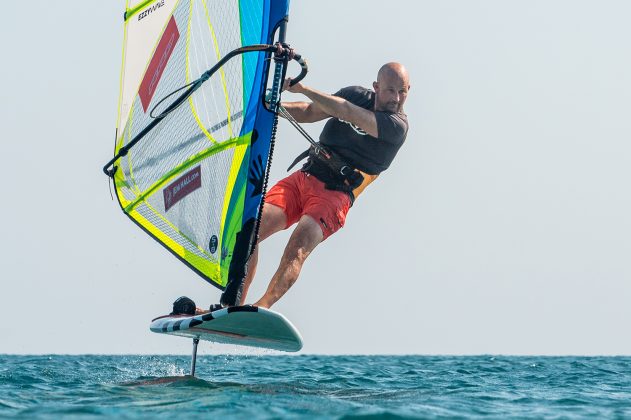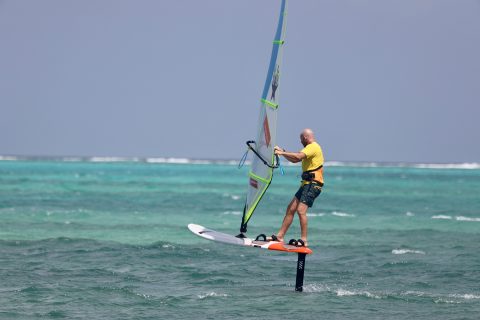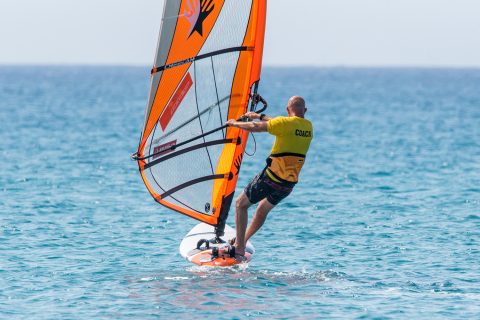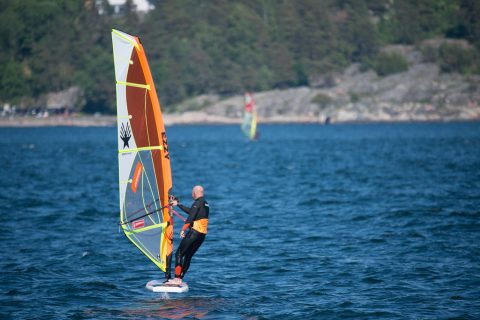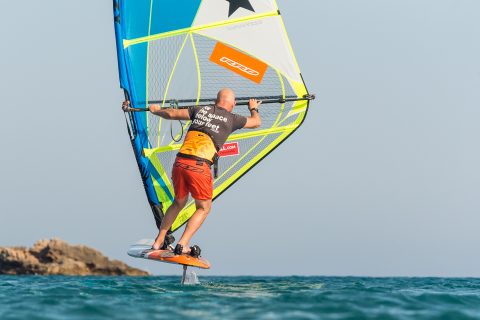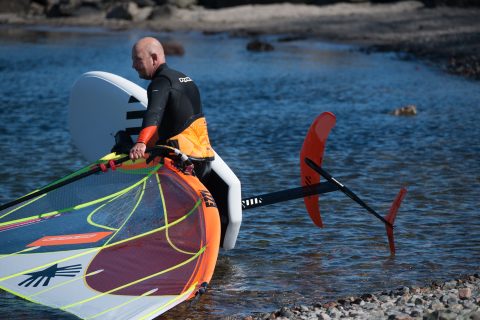JEM HALL
MOVE ON UP – WINDSURFING TECHNIQUE
FOILING AROUND
From our November / December 2020 issue Jem Hall shares his reflections on learning to wind foil.
Photos Radical Sports Tobago // Carsten Müller //Eye Sea You.
I would like to share with you my reflections after learning to wind foil over the last 6-7 months. I will be looking to reflect how it can help your windsurfing as the very mention of this term can polarise opinion. I, perhaps like some of you, was a tad suspicious of this new potentially ‘no harness’ sport, but this year, as Norwegians say, ‘I went all in’. Foiling for me has been fun, deeply engaging and kept me sane in ‘these times’. It also reminded me of the benefit of trying something new – “if you don’t go, you won’t know!”
The positives
If you are still sceptical about foiling, perhaps it would help if I shared how I see foiling boosting your windsurf skills. This is not only from what I have felt, and reflected on, but also what I have seen on the water in Tobago, Rhodes and around Oslo.
- Time on the water – foiling is best in lighter winds, so it gets you to the beach more, and then if the wind really comes up you are already there, ready to windsurf.
- Pumping – this is very important for more flight time. This skill is not the best in most windsurfers, so foiling will really boost your sail pumping and leg pumping, because if you do not do it right, you will not get up on the foil.
- Fronting up – when you are up on the foil the majority of your control will come from pulling down hard on your front arm and pushing down on your front leg. These actions will also really help your regular blasting.
- Eyes wide open – as you can get up in such low wind speed gusts, you will become better at looking upwind to see these and spotting the lulls that follow them. In general I have found myself way more tuned in to reading both the water and wind whilst out foiling.
- Oversheeting – this has very bad effects on your flight, and foil gybes, and will see you touching down a lot. Whilst windsurfing you are less punished for this action, but it is one of the hardest habits to get ‘rig wrestlers’ to lose.
- Tacking – foil gybes are hard, so you will do more tacks at the start of your journey and we all know how useful this is for your windsurfing too.
- Gybing – do all the right actions in a foil gybe and you will get either a dry gybe or the amazing feeling of a full foil gybe. A lot of these actions will massively improve your regular carve gybes.
- You can’t see the frown, but the level of focus is huge, and unhooked felt better at first. Photo by Radical Sports Tobago.
Foil foibles
Learning to foil, and getting better at it, has given me amazing sensations and also some bizarre moments. I would like to share some of these with you:
- You may not yet be a ‘whooper’ on the water, but when you get stable flight on the foil, I dare you not too. I found myself really shouting after great blasts or completed gybes.
- When you are up above the water it feels amazing and you feel so high.
- On your first sessions you realise that you have not uphauled a lot for a while, and so you have to reacquaint yourself with this.
- After blasting around on the foil you will think it is windy until you come to waterstarting and realise that it isn’t.
- In my focus to not kick the foil when waterstarting, I moved my body position forward and then found myself with my front leg going through the harness line.
- After using long harness lines for years, when I first started using the necessary shorter lines, I was terrified and felt glued to the boom. This will pass!
- Foiling is quiet and so when windsurfers ‘sound’ really close to you they are not.
- On some crashes the foil comes up high and makes a certain noise and this is the time to correct it or get ready to get launched. This had me laughing a lot.
- Foil gybes tend to be wide, and with quite a lot of momentum, and mid gybe when you have to make the foot change I was having some crazy internal dialogues, as I knew there could be a trip to the water coming up soon.
- In my first sessions I was so proud to be up on the foil that when I came to the beach I forgot to anticipate dropping down and grounded the foil. This is not cool, even though I thought I was.
- Open the sail and learn to work the foil. Photo by Eye Sea You.
Jem’s foiling gems
I am not a practiced foil coach as yet, but here are a few tips I think will help both your windsurfing and foiling:
- Pumping – look to improve this and aim to keep the arms straight and look to row the rig and don’t oversheet the sail.
- Early straps – practice getting in the straps non-planing on your bigger windsurf board so that it is more assured once you come to foil as this is where you will be starting from on a strapped-up wind foil board.
- Embrace the tack – when you are learning to foil and just looking to get control and consistent ride height, know that gybes are hard, so tack.
- Unhooked – I preferred to be unhooked in my first 10 sessions on the foil as it ensured I was not either under or oversheeting, and that I had more control and could react quicker. Windsurfers could definitely be stronger and more efficient if they were great at sailing unhooked.
- Straighten up – being over the board and having straight legs is the stance required for foiling. If you are used to being low and out then this will feel weird at first. Embrace it and know that the higher boom and shorter harness lines helps you adopt this stance.
- Soft is fast – after getting comfy with your stable ride height, it is time to boost your speed and this is achieved by softening the legs so they are straight but not locked. This was a breakthrough for me and is described well in one of Sam Ross’s fantastic foiling videos!
- Footsteering – after getting plenty of stable runs on the foil practice steering up and downwind unhooked to feel how to steer and how to use the rig too. This feels good and will help your gybes, same too on a windsurfer.
- Precision – be conscious that the foil can be quite sensitive so be extra precise when moving hands and feet.
- Starts – whilst uphauling is de rigueur I preferred to do the light wind waterstart with my front hand on the mast. This got me up and forward on the board away from the foil. Again, this is a fab move for both sports.
- Game plan – know that a foil really flies upwind, so early in your flight plans learn to go downwind in the cruisey sail open style or you really can get stuck upwind.
- Harness work – practice hooking in and out a lot. It will really help your gybing and your all-round confidence and stability.
- Enjoy the falls – they will happen and are not as bad as they look.
- Drop down – be confident and focussed in your foil gybes and bring your ride height down to become more stable.
- Depth – remember that when you drop down from foiling, if you are close to the beach the foil will hit the bottom. In general all wind sports stop too close to the beach and without enough control / style. Better to be safe than sorry with a foil and stop further out from shore.
- If you are windsurfing with beginner or improver foilers, do not get close to them and race them, as they can be moments from ‘detonation’.
- Trying to find the sweet spot in Oslo. Photo by Carsten Müller.
Summary
I learnt over a week in Tobago, with its medium winds, flatter water and depth at high tide, an hour a day gave me huge momentum. Thanks to Josh for his time with me out there! With this in mind, I strongly recommend getting some coaching. I continued at home through spring and summer, as with global lockdown I found myself at home. I had good and bad sessions but loved the journey so much and was often humbled by the experience.
Foiling could be like skiing in that you learn it whilst away and then have more sessions on future holidays, or do it at home and discover it will triple your water time and fall in love with learning again.
- Foil gybes will help your carve gybes. Photo by Eye Sea You.
Kit and tuning:
Board choice – I mixed up my learning on both a foil ready freemove board and the short dedicated RRD foil board, the pocket rocket. I liked both, but I enjoyed feeling different foot positions on the Pocket Rocket without straps attached. Try both setups if you can.
Foil choice – the early lift foil was what I went with, as I wanted to get out in lighter winds and with smaller sails. There are lots of options on foil types and designs, so think about what would favour your style, the conditions you want to get out in and what sort of wind foiling you want to do.
Sail tuning – I tuned a lot in the water, as it is a faff to get in and out with the foil. More outhaul as soon as I was too powered up and vice versa for less power.
Setup – initially I used my original long lines and regular boom height, but then after Harty’s piece I went for a higher boom and shorter lines and this is much better. Thanks to Peter and Sam Ross for all the tips!
Mastfoot – as per normal windsurfing, moving the mastfoot back and forward by a few cms made a big difference. Utilising more tuning on the foil sessions will see you more likely to tune your mastfoot position in normal windsurf sessions.
- When launching and landing remember these foils are big & long! Photo by Carsten Müller.
Conditions:
I found it much easier in flatter water, as the board is more stable for easier foot movements. I suggest looking for a good deep flat water spot to learn and improve at.
The majority of my improvements came in medium powered conditions. I learnt a lot with less power and drank a lot of sea when overpowered.
When it gets windy it is surprising how small a sail you can get onto and then feel comfortable and carry on learning with.
RRD boards, wetsuits & softwear, Ezzy sails & Black Project fins sponsor Jem Hall. Get him live and direct on one of his highly acclaimed coaching holidays, visit www.jemhall.com for more details. You can also follow him on twitter / Facebook / Instagram.


